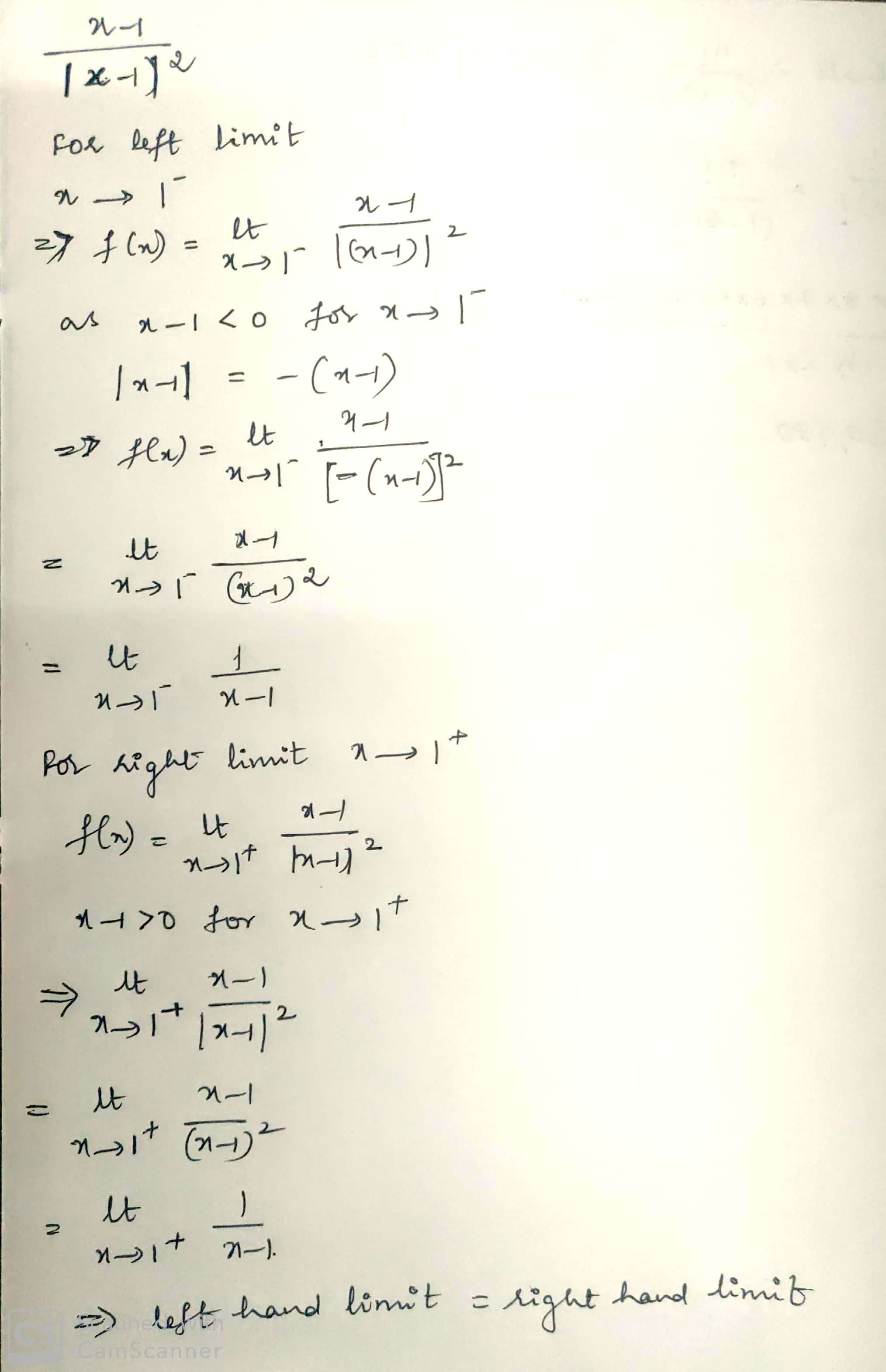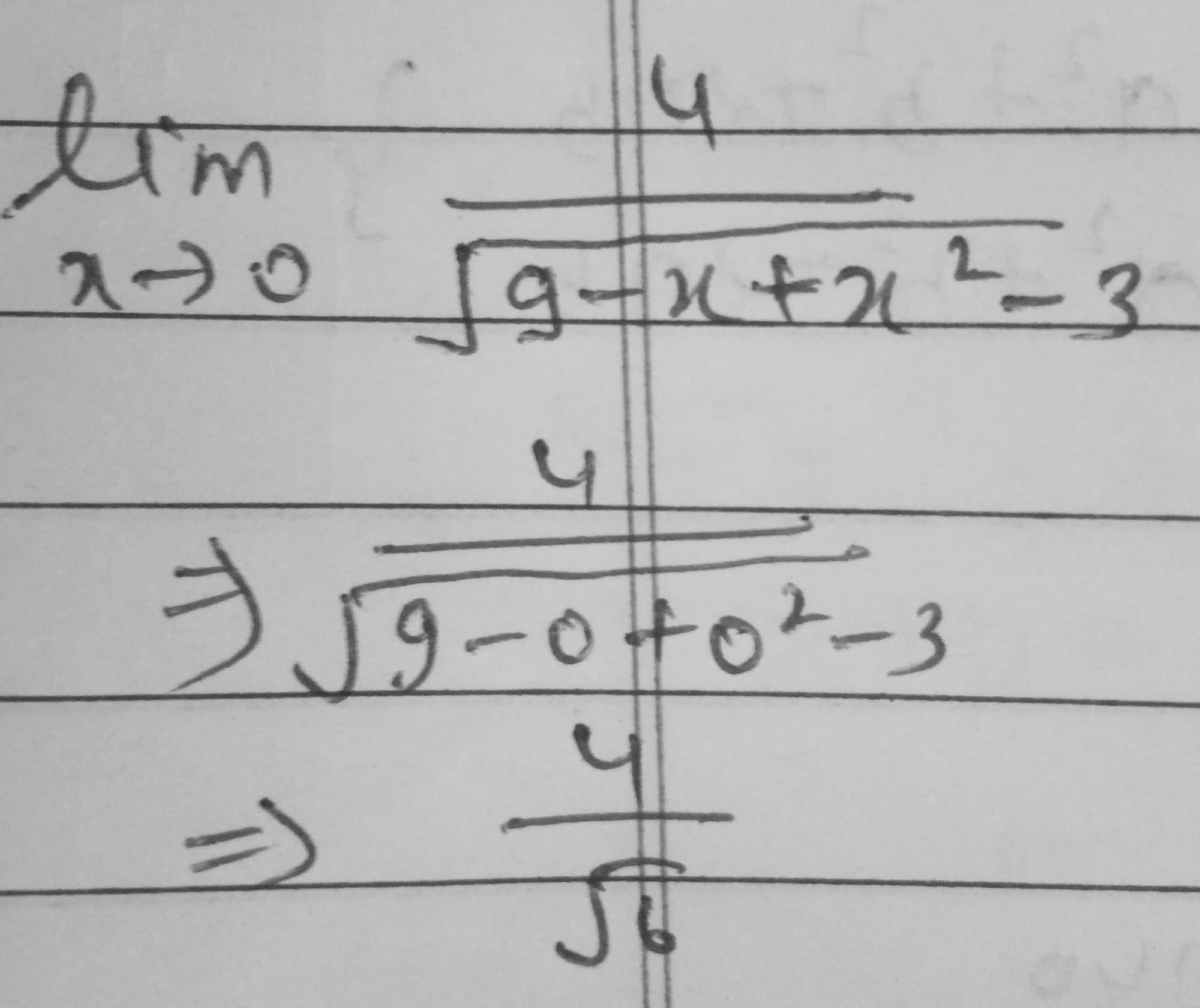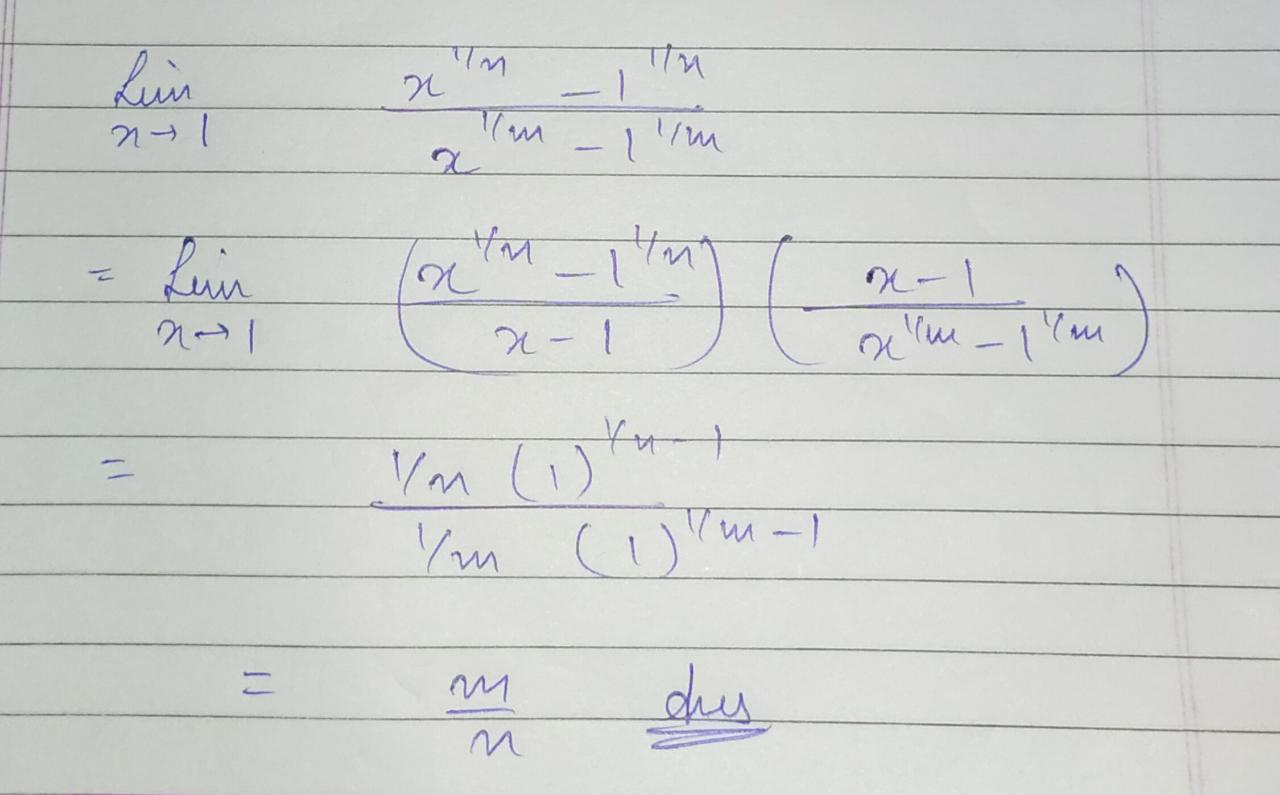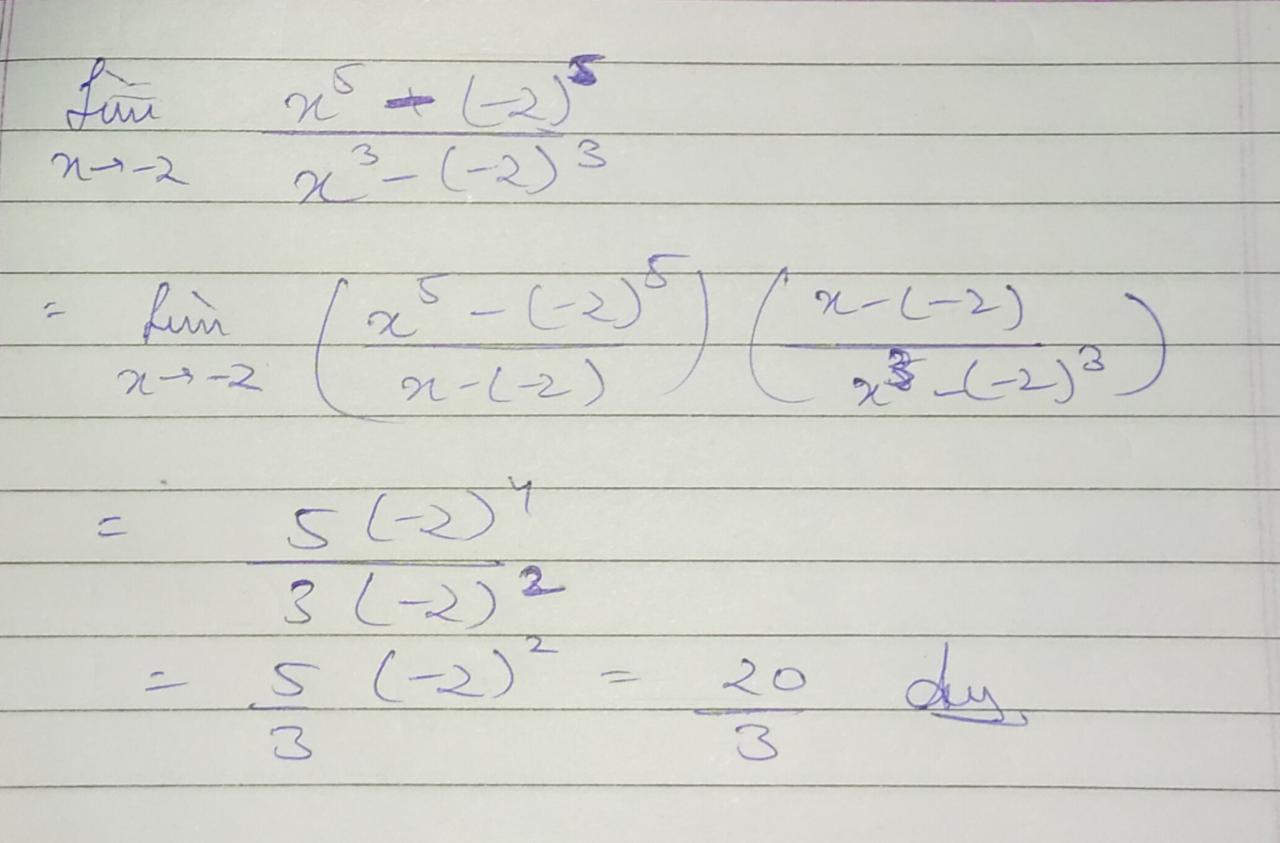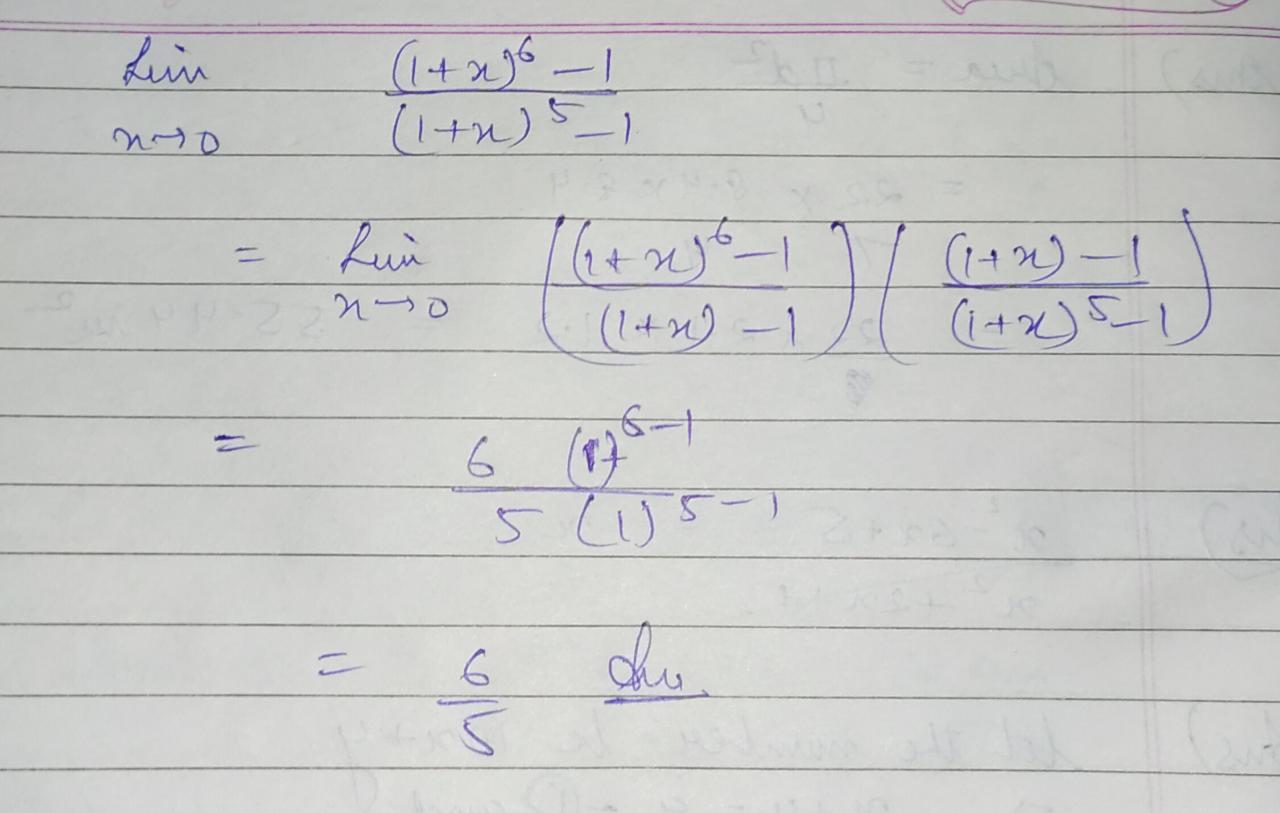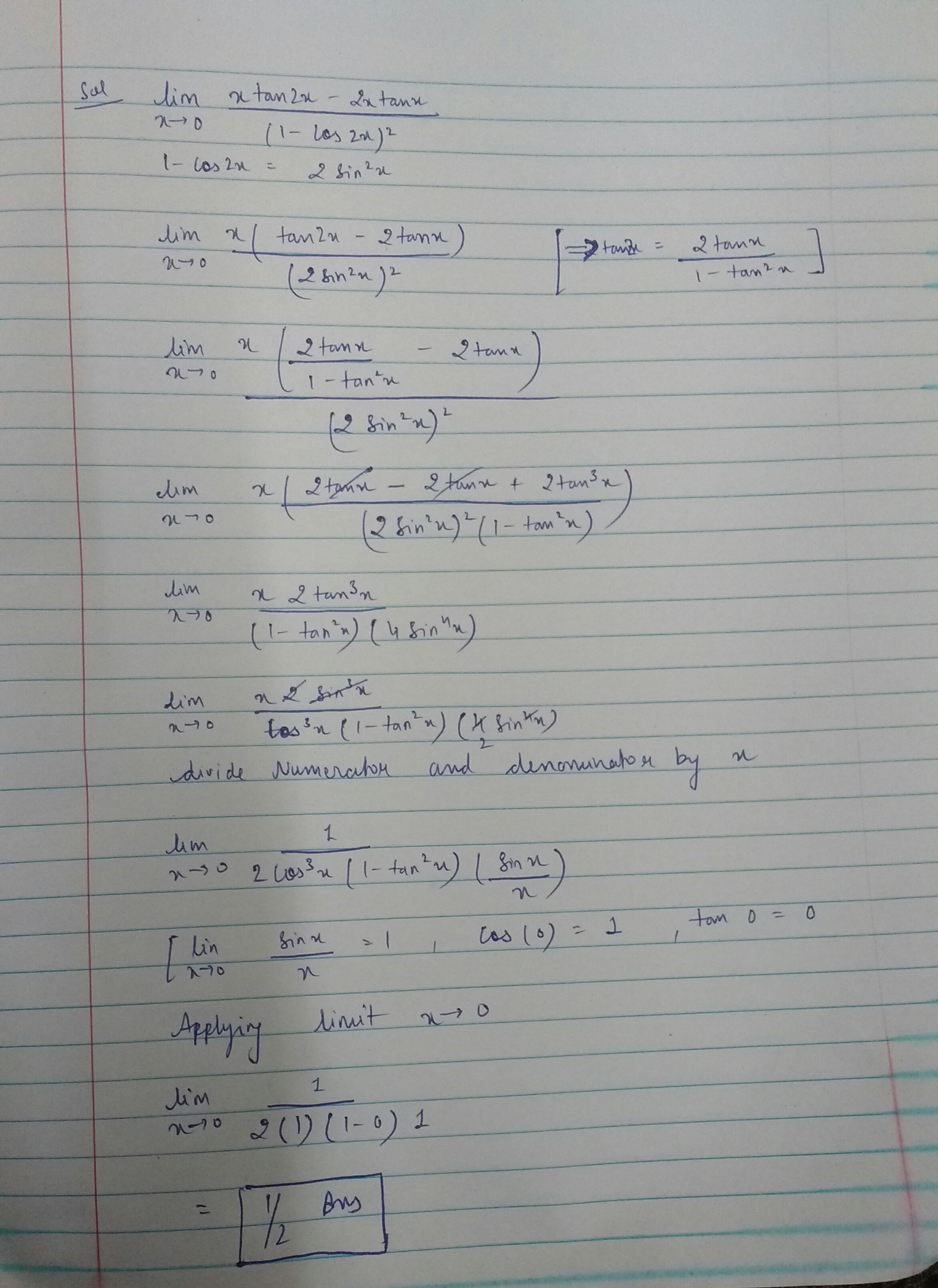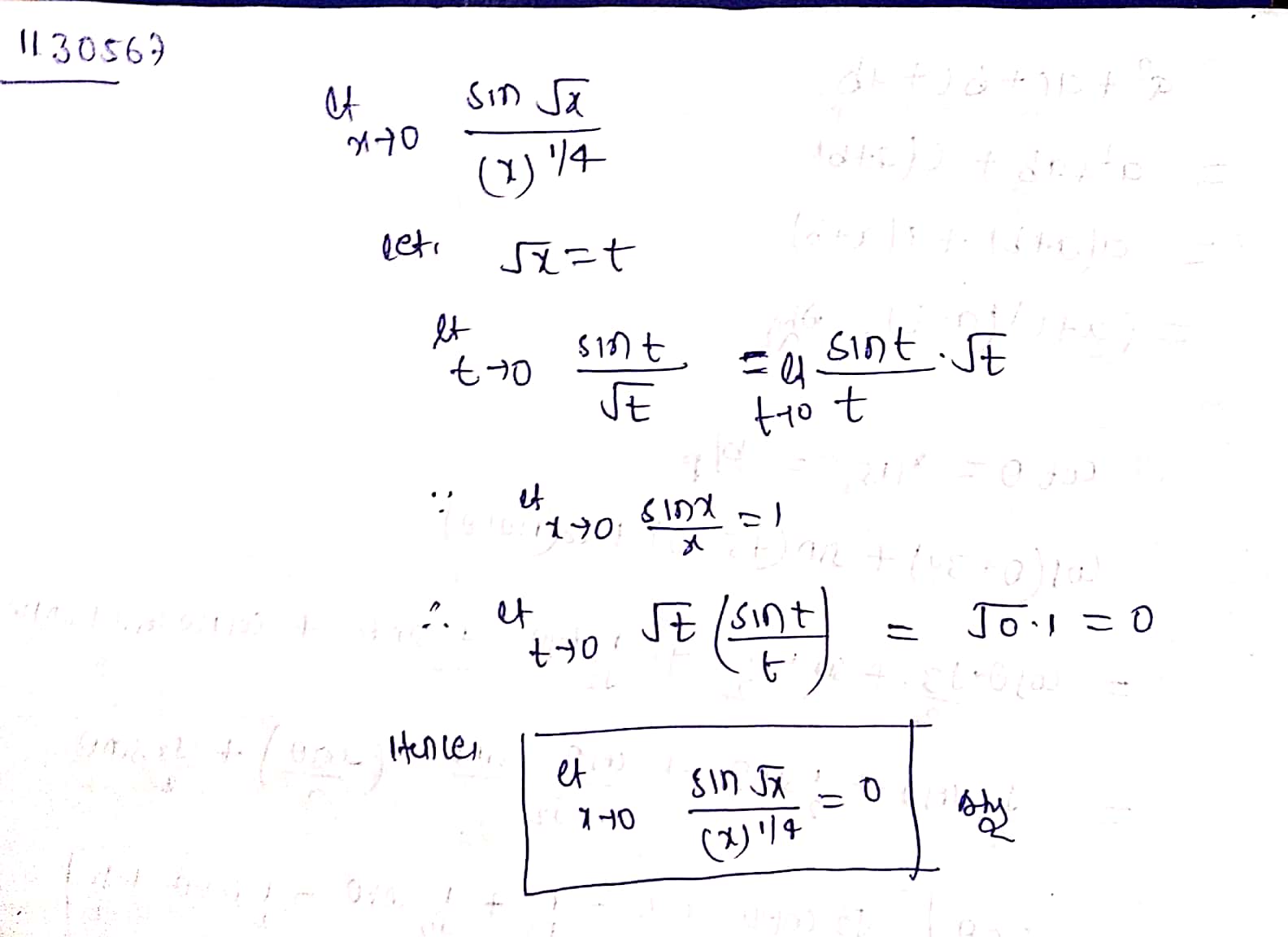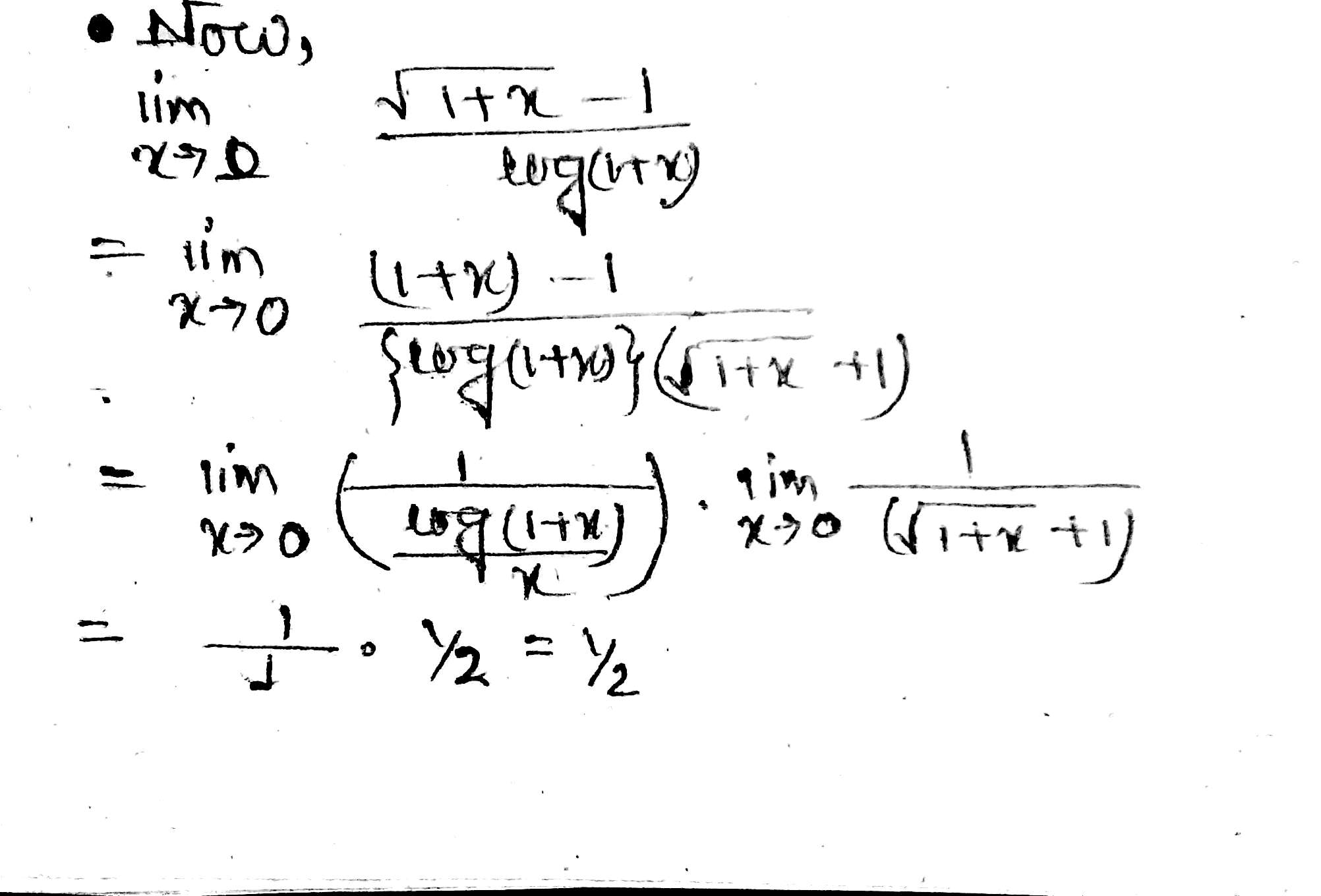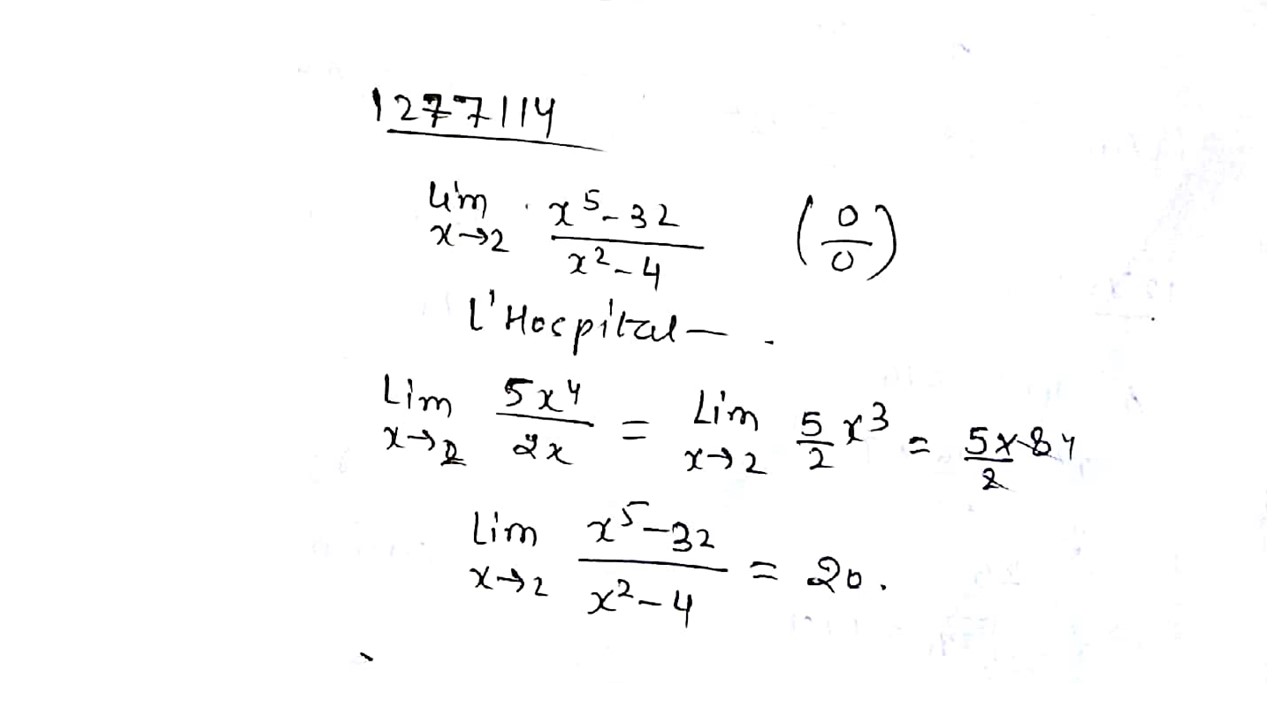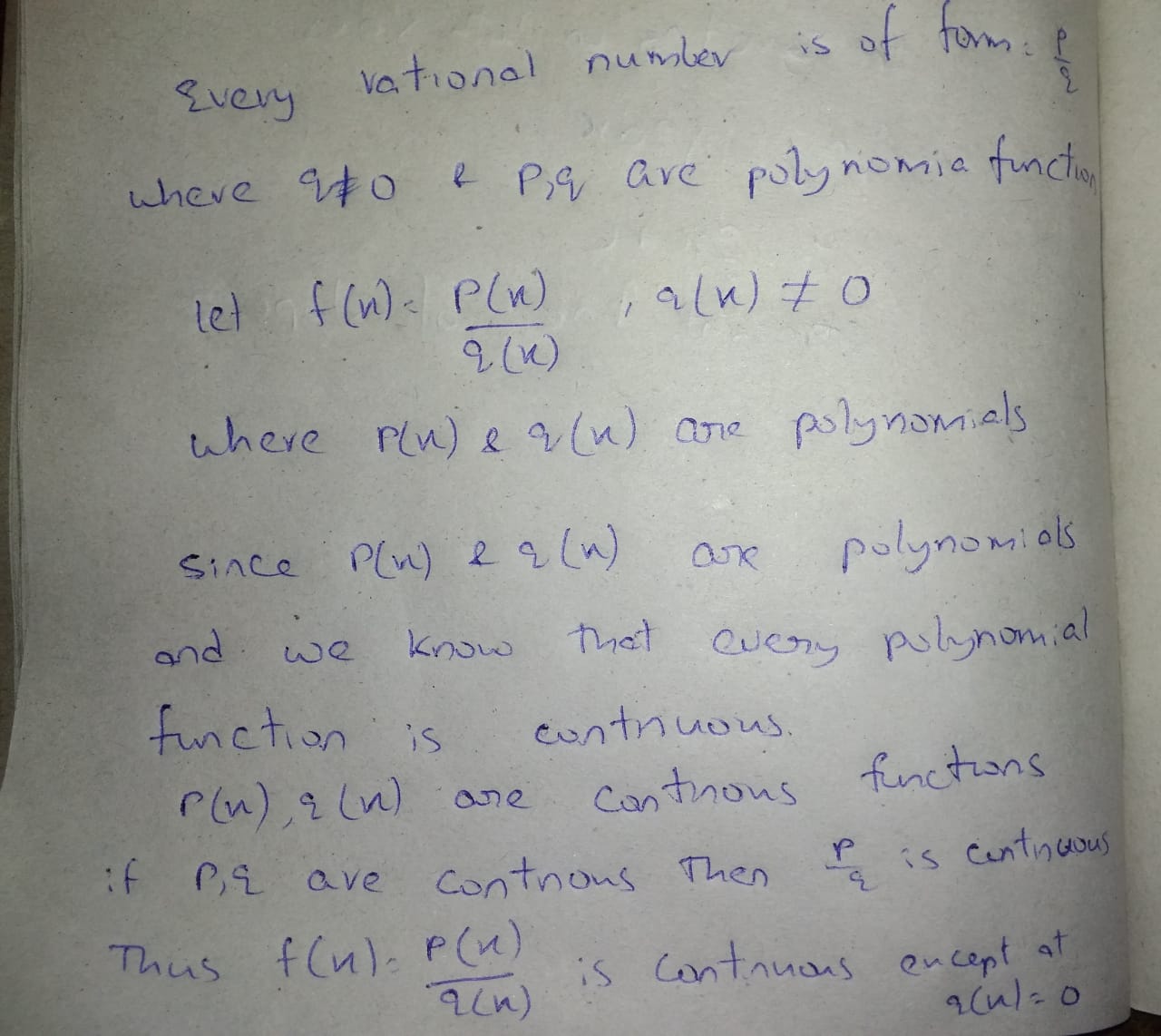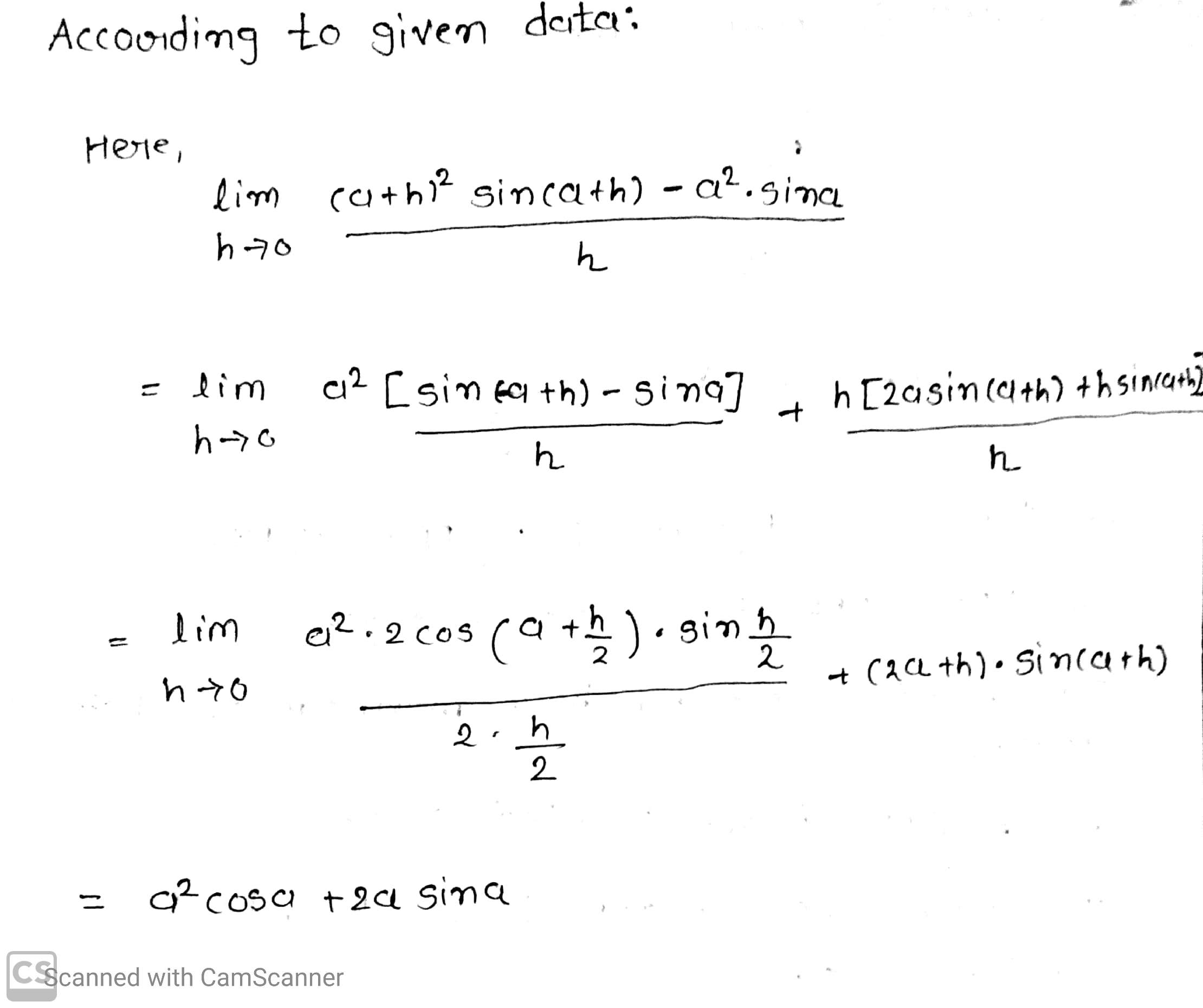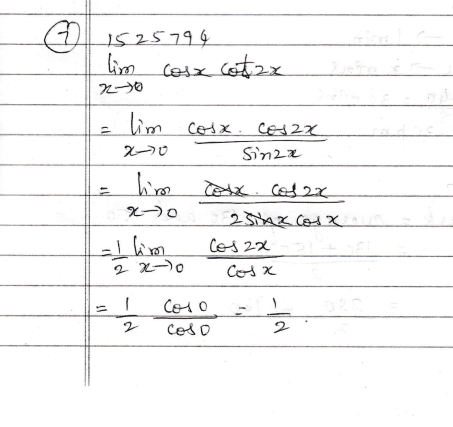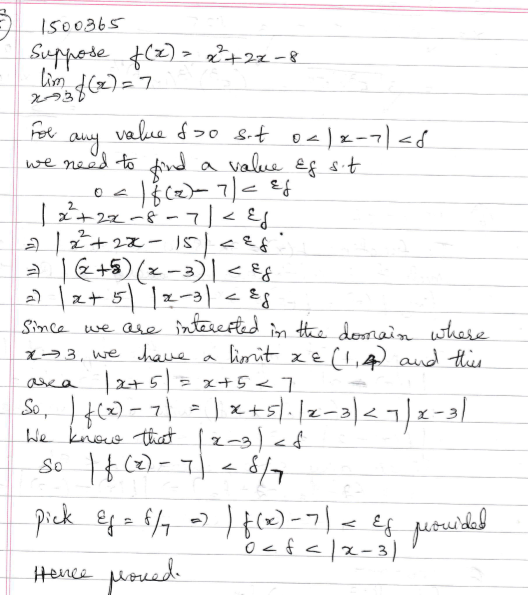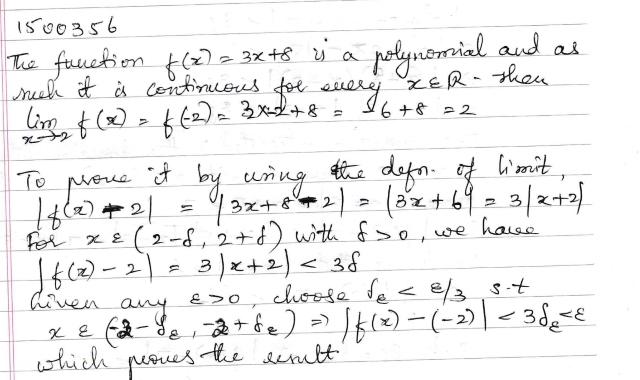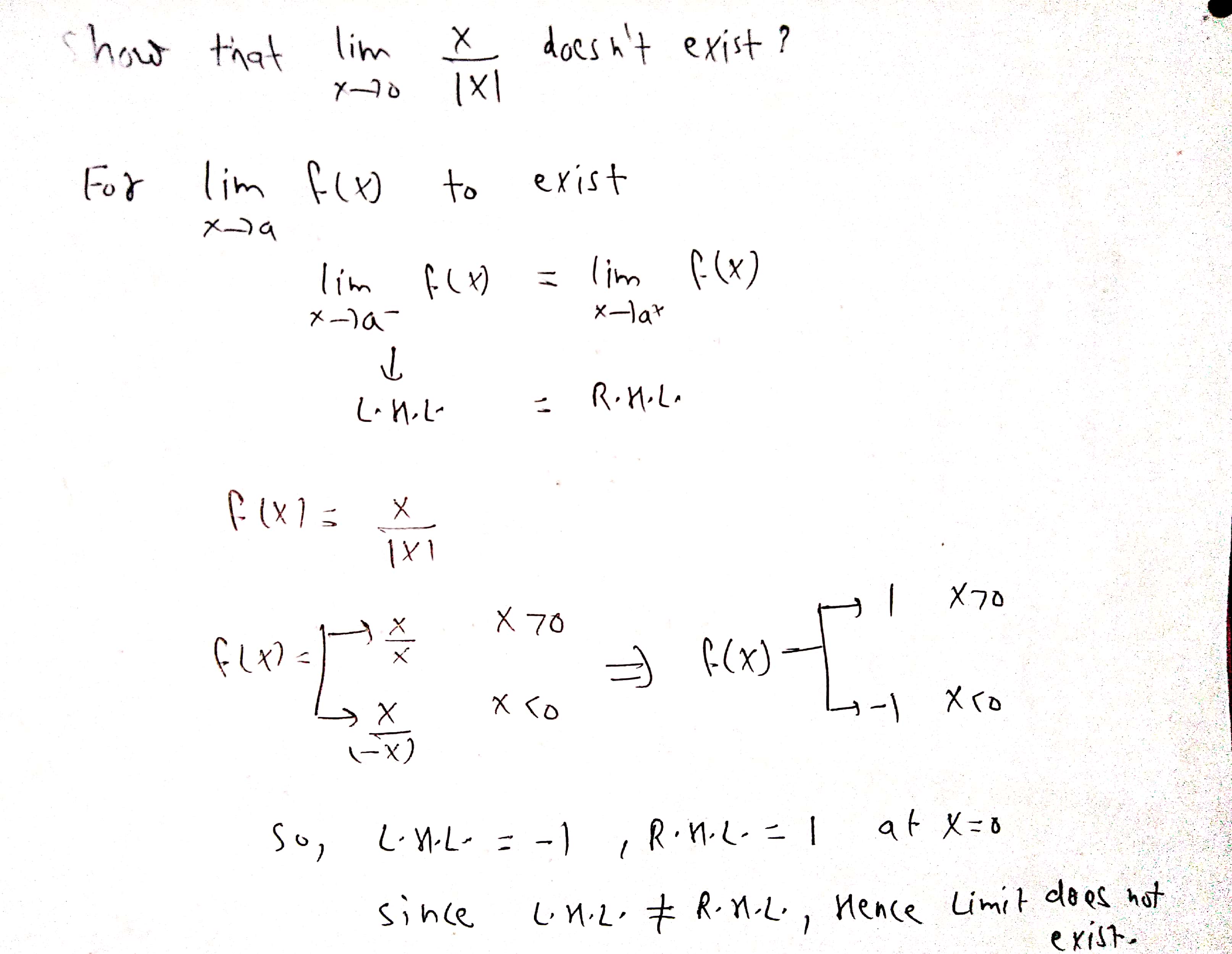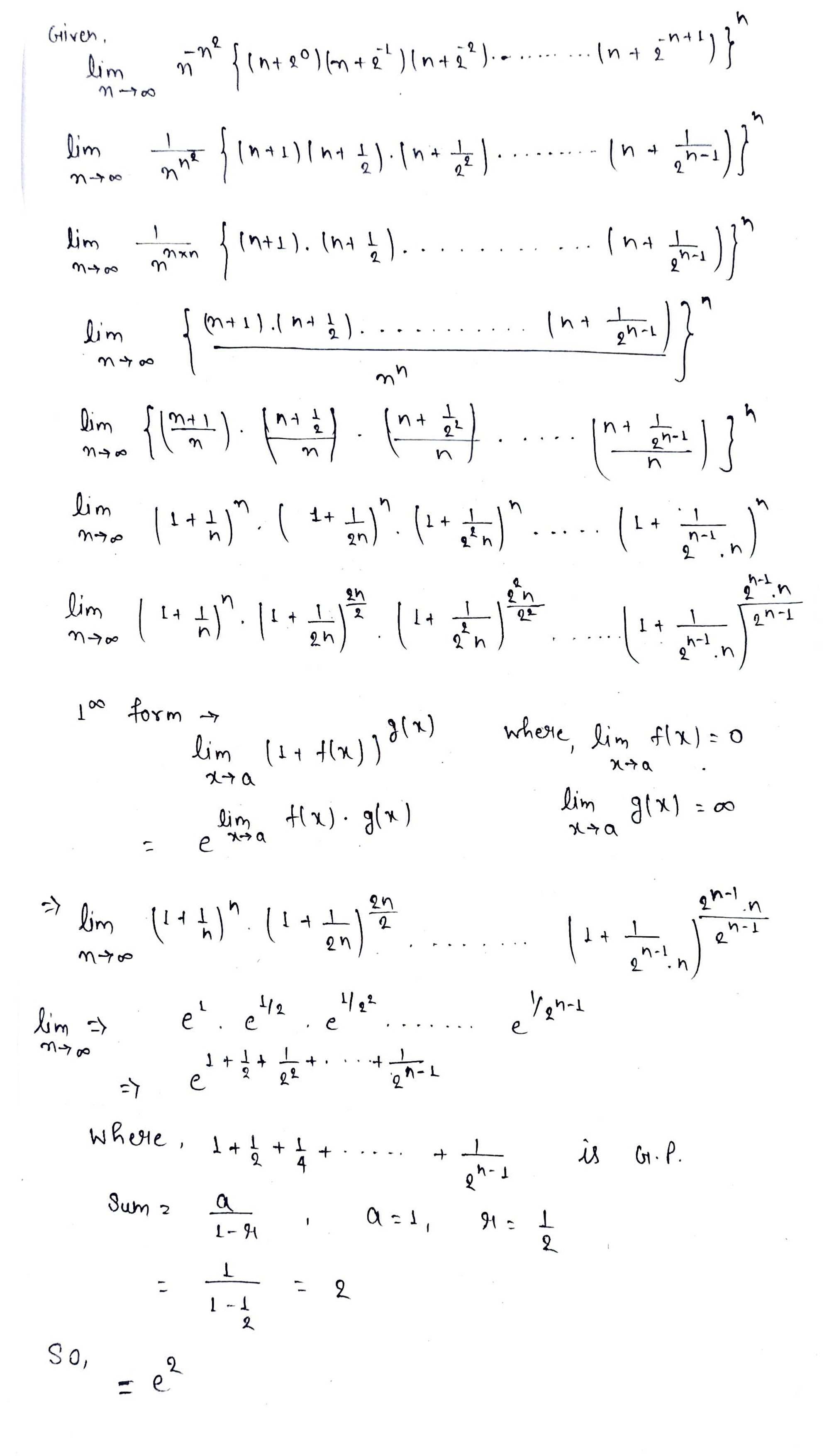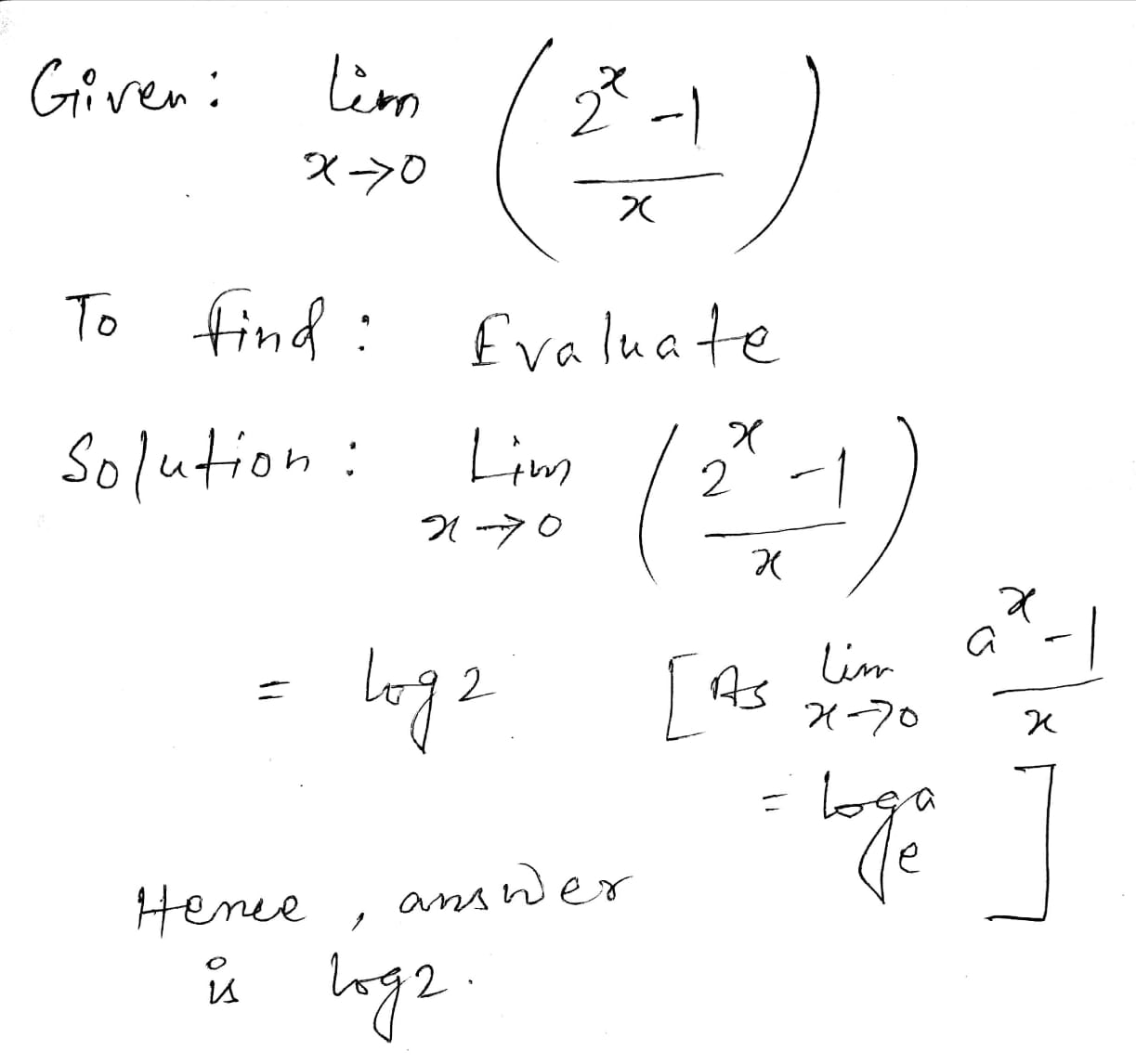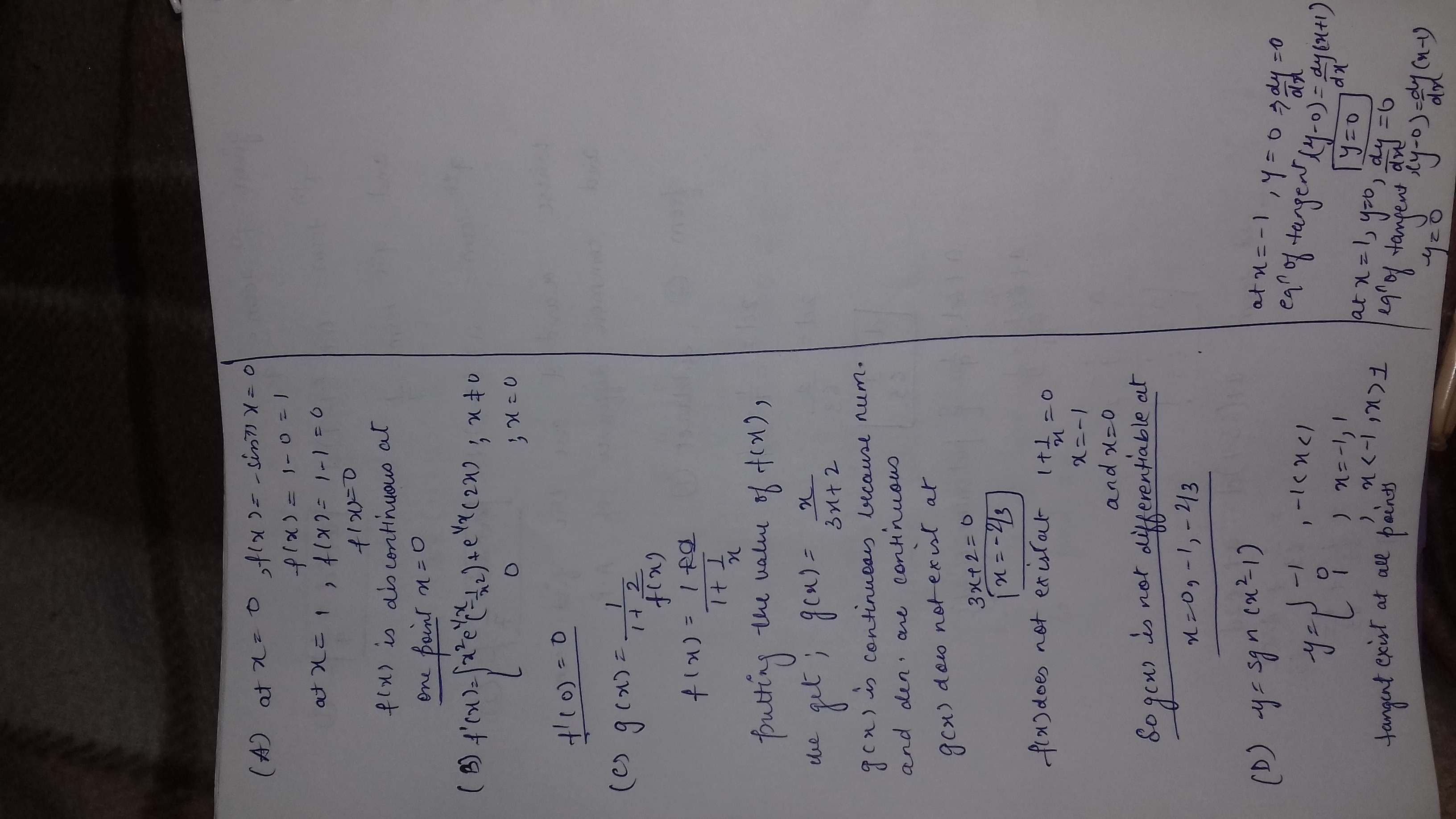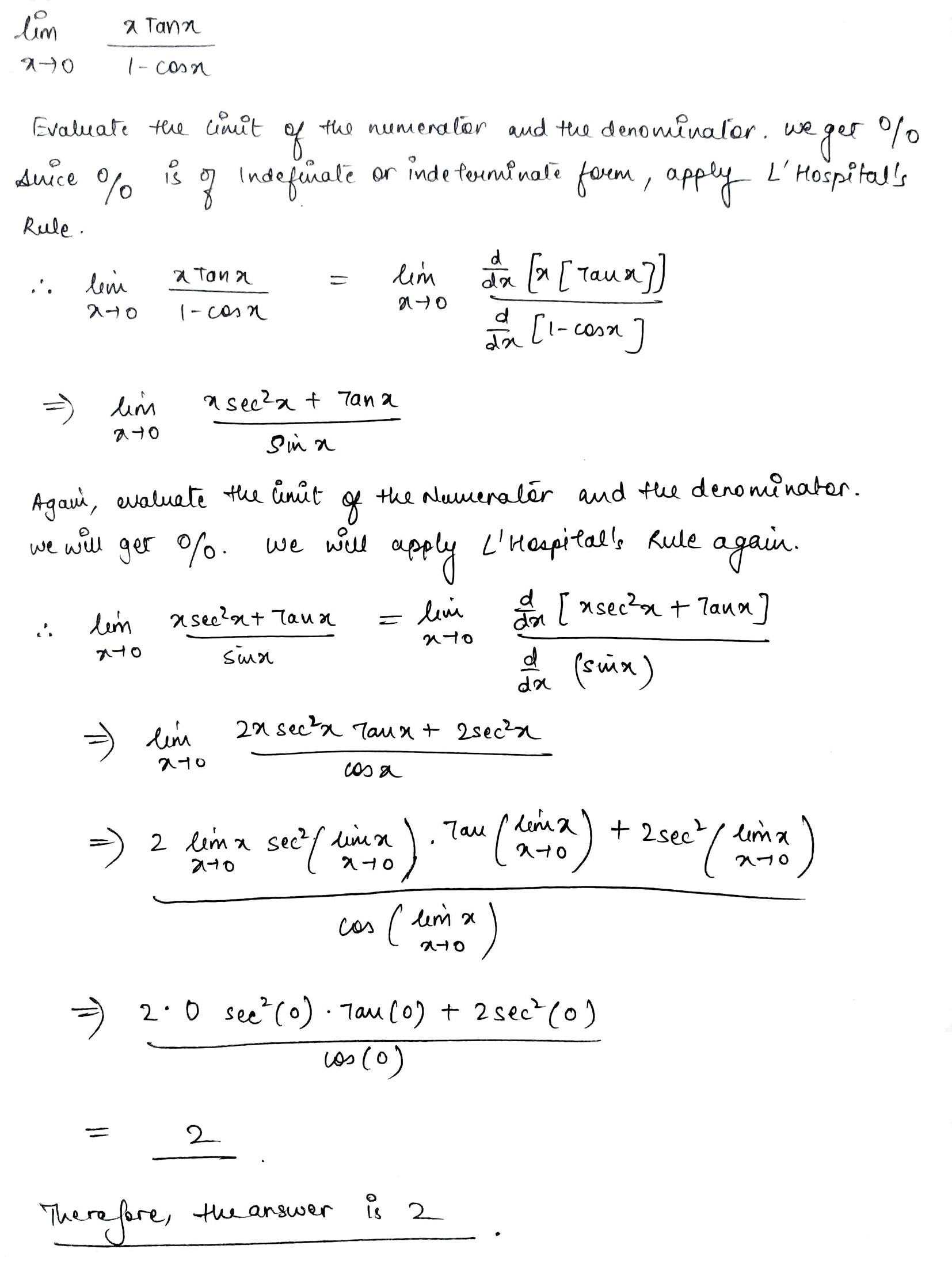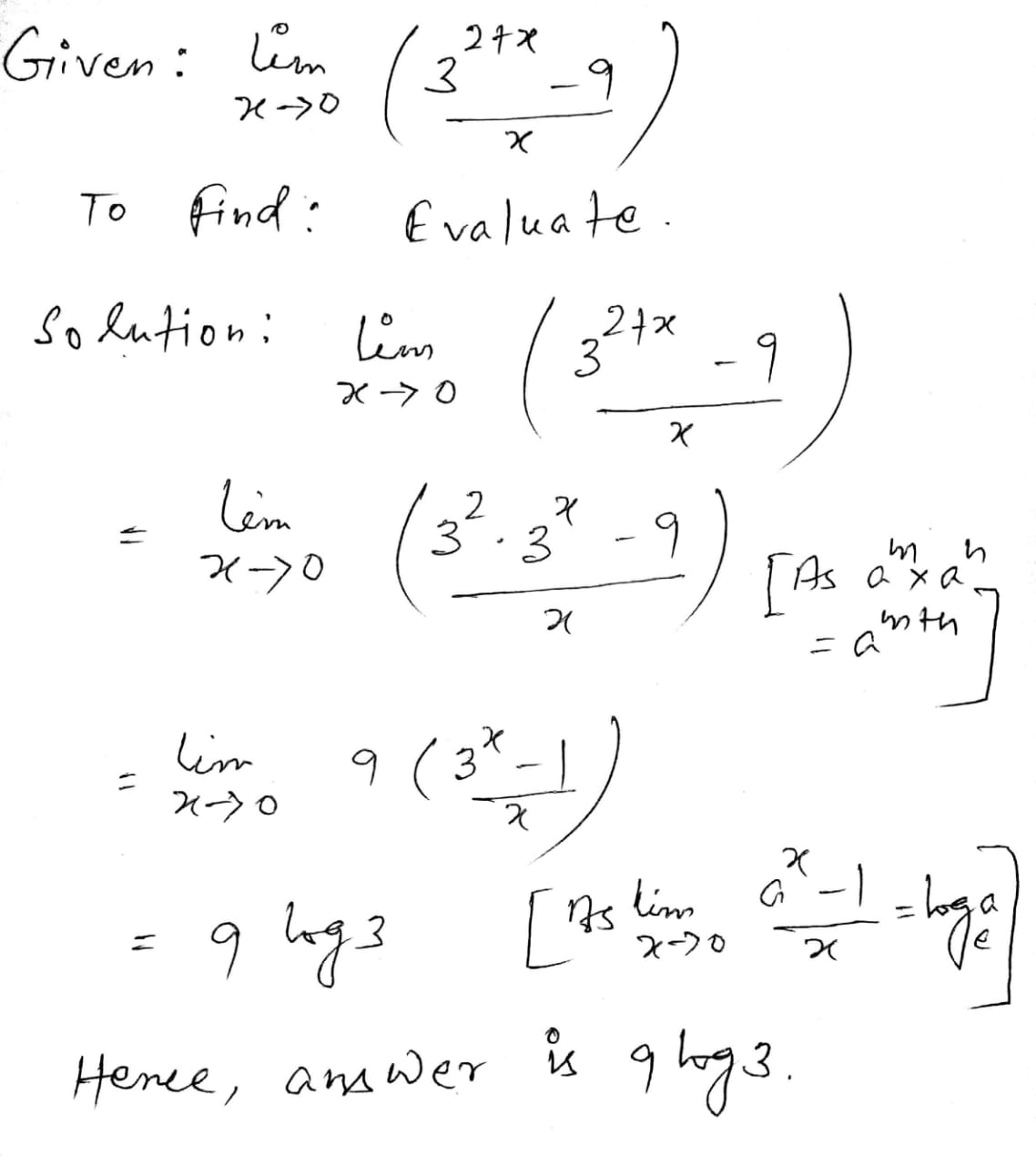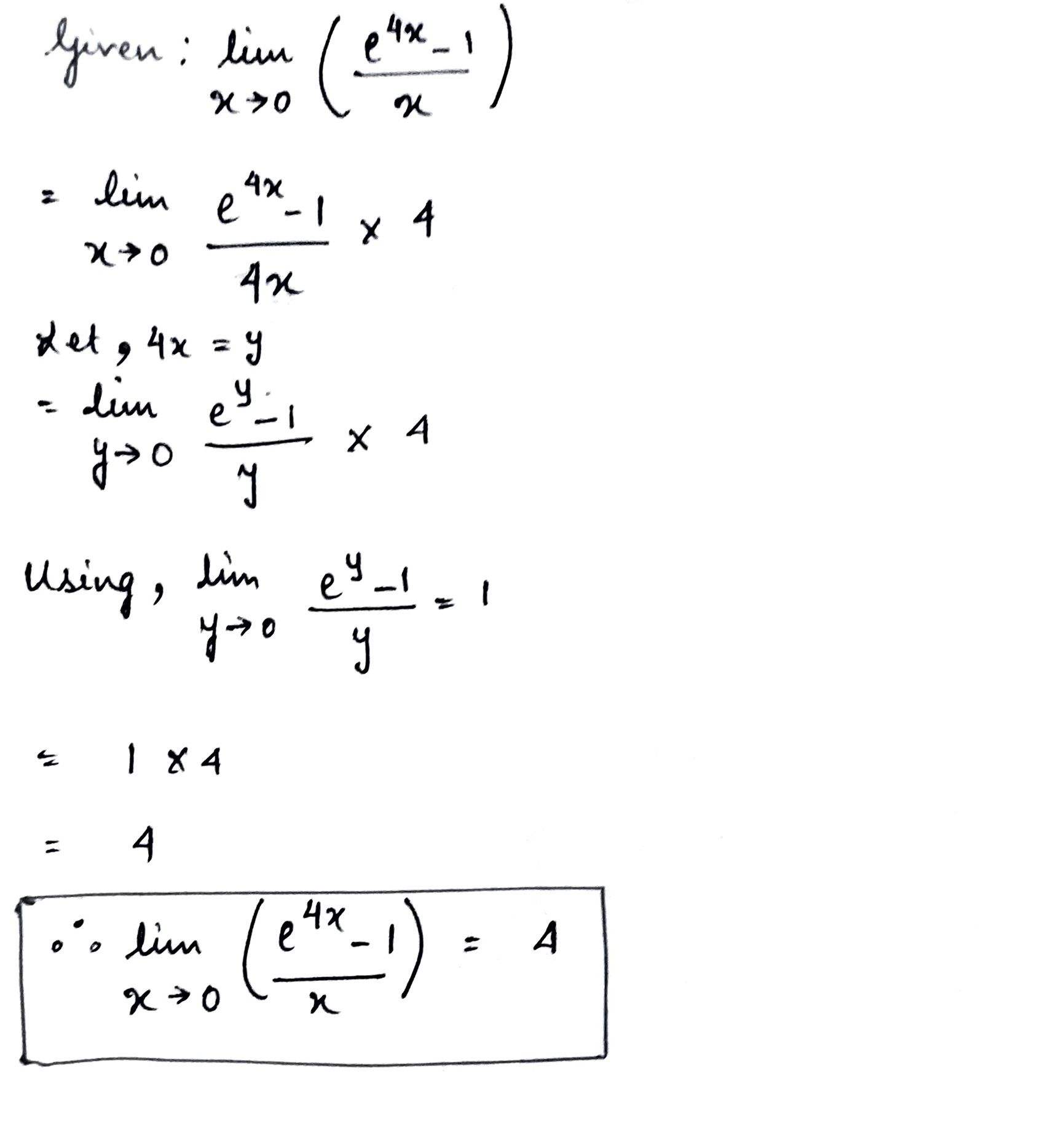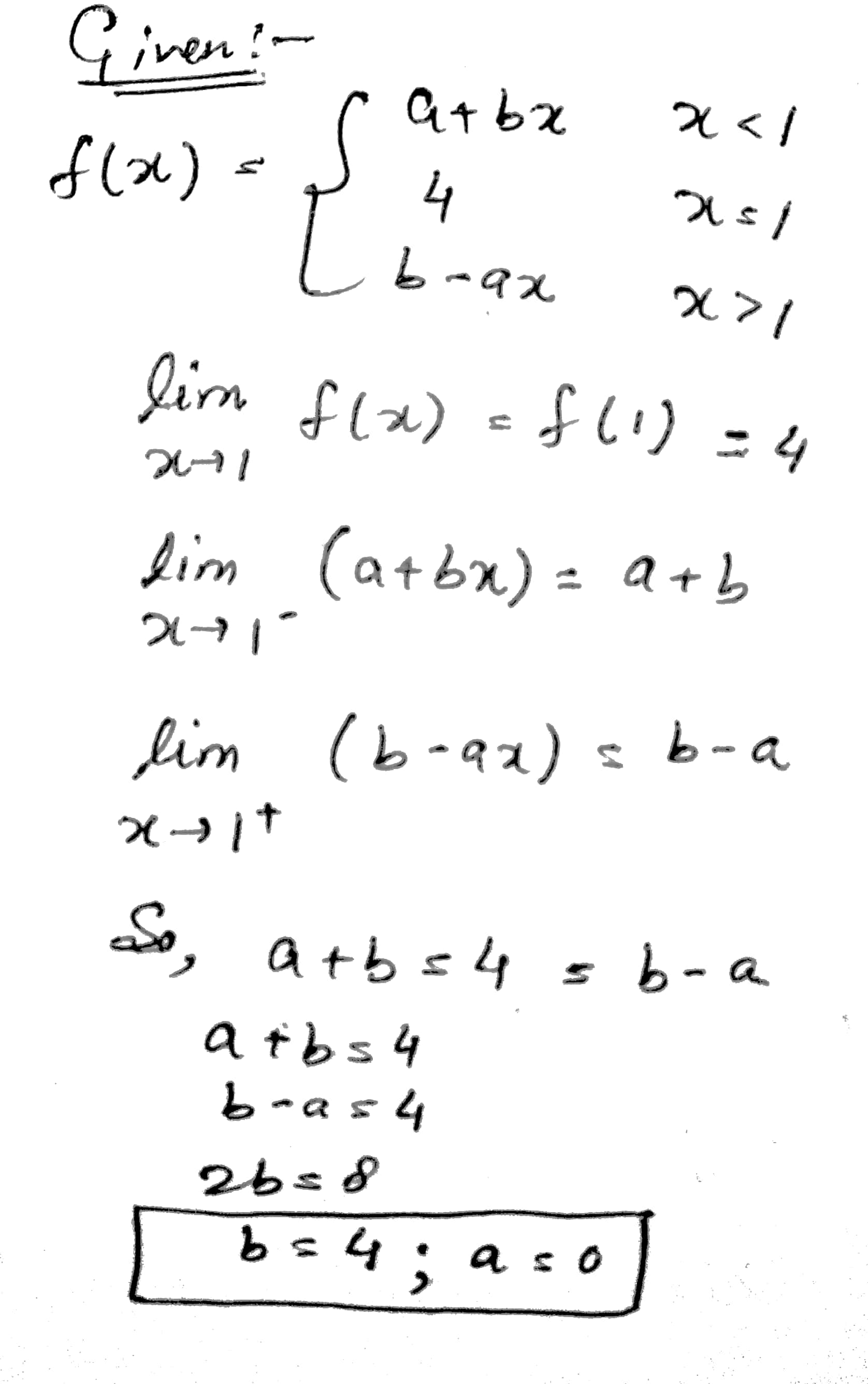Limits And Continuity - Class 11 Commerce Applied Mathematics - Extra Questions
Evaluate the given limit: $$\displaystyle \lim_{x\rightarrow 0}x\,\sec x$$
$$\lim_{x\rightarrow 0^-} \dfrac{|x|}{x} = -1$$
Show that $$\lim_{x \rightarrow 0^+} \dfrac{|x|}{x} = 1$$
$$f(x)=\dfrac{x-1}{|x-1|^2}$$
Find both right and left hand limit of limit is exist at x=1
$$\underset {x \rightarrow \infty}{lim}\left(\dfrac{1+2x}{1+3x}\right)^x$$
$$\lim\limits_{x\to 0}\dfrac{e^{2x}-1}{\sin 3x}=$$
If $$f\left( x \right) = \dfrac{{\tan x}}{{x - \pi }}$$, then$$\underset{x\to \pi }{\mathop{\lim }}\,f\left( x \right)=?$$
$$\underset{x\to \pi }{\mathop{\lim }}\,f\left( x \right)=?$$
$$\mathop {\lim }\limits_{x \to \infty} {\left( {1 + \frac{1}{x}} \right)^{2x}}$$
$$Lt _ { x \rightarrow 0 } \dfrac { x } { \sqrt { 1 + x } - 1 }$$
Evaluate $$\lim_{x \rightarrow 0 }\dfrac{\log x+\log\dfrac{1+x}{x}}{x}$$
$$\mathop {\lim }\limits_{x \to 0} \frac{4}{{\sqrt {9 - x + {x^2} - 3} }}$$
$$\displaystyle \lim _{ x\rightarrow 0 }{ \dfrac { \log{(3+x)}-\log{(3-x)} }{ x } } $$
Solve:
$$\displaystyle \lim_{x\rightarrow 0}\dfrac{3\sin^{2}x-2\sin x^{2}}{3x^{2}}$$
$$\underset { x\rightarrow a }{ \lim } { \left( \dfrac { x+1 }{ 2x+1 } \right) }^{ { x }^{ 2 } }=$$
$$\mathop {\lim }\limits_{x \to 3} \cfrac{{{x^2} - x - 6}}{{{x^3} - 3{x^2} + x - 3}}$$
The value of $$\displaystyle x\xrightarrow { lim }\infty\, x\sin\frac{\pi}{4x}\,\cos\frac{\pi}{4x} $$
Evaluate $$\lim _ { x \rightarrow 2 } \dfrac { x ^ { 5 } - 32 } { x ^ { 3 } - 8 }$$
$$\mathop {\lim }\limits_{x \to 1} {{\root n \of x - 1} \over {\root m \of x - 1}}$$ ( m and n integers) is equal to
Evaluate: $$\mathop {\lim }\limits_{x \to - 2} {{{x^5} + 32} \over {{x^3} + 8}}$$
$$\lim _{ x\rightarrow a }{ \dfrac { { x }^{ 7 }-{ a }^{ 7 } }{ { x }^{ }-{ a }^{ } } }$$
Evaluate: $$\lim _ { x \rightarrow 0 } \dfrac { ( 1 + x ) ^ { 6 } - 1 } { ( 1 + x ) ^ { 5 } - 1 }$$
Evaluate $$ \underset {x \rightarrow -2 } {\lim} \dfrac{tan \, \pi x}{x + 2} $$
Prove that $$ \underset {x \rightarrow 0 } {\lim} \left ( \dfrac{e^x - 1}{x} \right ) = 1 $$
Evaluate $$ \underset {x \rightarrow 0 } {\lim}\dfrac{x \, tan \, 4x}{1 - cos \, 4x} $$
The value of $$ \underset {h \rightarrow 0 } {\lim} \dfrac{e^{2h} - 1}{h} $$
$$\displaystyle \underset{x\rightarrow \infty }{lt}\frac{e^{x^{2}}-1}{e^{x^{2}}+1}= $$
$$\displaystyle \lim_{x\rightarrow \pi /3}\frac{3\:\tan x-\tan ^{3}x}{\cos (x+\dfrac{\pi}{6})}$$ is equal to
The value $$\displaystyle \lim_{x\rightarrow \tan^{-1}3}\frac{\tan ^{6}x-2\tan ^{5}x-3\tan ^{4}x}{\tan ^{2}x-4\tan x+3}$$ is
Prove that the derivative of an odd function is always an even function.
Evaluate the Given limit: $$\displaystyle \lim_{x\rightarrow 0}\frac{\sin \,ax}{\sin \,bx},a\,,b\neq 0$$
Evaluate the given limit: $$\displaystyle \lim_{x\rightarrow 0}\frac{\cos \,2x-1}{\cos \,x -1}$$
Find the value of $$\displaystyle \lim_{x\rightarrow \frac{\pi }{2}}\frac{\tan 2x}{x-\frac{\pi }{2}}$$
Evaluate the given limit: $$\displaystyle \lim_{x\rightarrow 0}\frac{ax+x\,\cos \,x}{b\,\sin \,x}$$
$$\lim_{x \rightarrow a} \dfrac{x cos a - a cos x}{x - a}$$
Find: $$\displaystyle\lim_{n\rightarrow \infty}\displaystyle\sum^{n}_{r=1}=\frac{1}{16r^2+8r-3}$$.
Calculate the following limits.
$$\displaystyle \lim_{x \, \rightarrow \, 0} \, \frac{sin \, 3x}{2x}.$$
Find the following limit.
$$\displaystyle \lim_{x \, \rightarrow \, 0 } \, \frac{\cos \, (x/2) \, - \, \sin \, (x/2)}{\cos \, x}.$$
Solve $$\lim _{ x\rightarrow 2 }{ (\dfrac { { x }^{ 5 }-32 }{ { x }^{ 3 }-8 } ) }$$
Solve $$\lim _{ x\rightarrow 0 }{ \dfrac { \cos { x } -\cot { x } }{ x } }$$
Apply the lmitsto given expression $$\displaystyle\lim_{x\rightarrow 0}\left(\left((x+1)(x+2)(x+3)(x+4)\right)^{\dfrac{1}{4}}-x\right)$$.
Solve: $$\displaystyle \lim_{ n\rightarrow\infty}$$ $$\dfrac{\Sigma n^2 \, \Sigma n^3}{\Sigma n^6} =$$? If your answer is in the form $$\dfrac{p}{q}$$ ,then find $$|p-q|$$.
$$\displaystyle\lim_{x\rightarrow 0}\dfrac{x\tan 2x-2x\tan x}{(1-\cos 2x)^2}$$ equals?
Evaluate: $$\mathop {\lim }\limits_{x \to 3} \left[ {\dfrac{1}{{x - 3}} + \dfrac{{9x}}{{27 - {x^3}}}} \right]$$
The value of $$\displaystyle \underset{x\to \infty }{\mathop{\lim }}\,\left( x\sin \left( \dfrac{3}{x} \right) \right)$$
If $$\displaystyle \lim_{x\rightarrow 0} \dfrac {\sin \sqrt {x}}{\sqrt [4]{x}}$$.
Evaluate $$\lim_{x\rightarrow 1}\frac{x^{15}-1}{x^{10}-1}$$
Solve: $$\underset{x \rightarrow 2}{\lim} \dfrac{a^{\tan x} - a^{\sin x}}{\tan x - \sin x}, a > 0$$
Evaluate:$$\mathop {\lim }\limits_{x \to 0} \left( {{{\left( {x + 1} \right)}^{\frac{2}{3}}} - {{\left( {x - 1} \right)}^{\frac{2}{3}}}} \right)$$
Solve $$\mathop {\lim }\limits_{x \to \frac{\pi }{4}} \dfrac{{f\left( x \right) - f\left( {\dfrac{\pi }{4}} \right)}}{{x - \dfrac{\pi }{4}}}$$, where $$f\left( x \right) = \sin 2x$$
Evaluate the limit
$$\mathop {\lim }\limits_{x \to \frac{\pi }{6}} \frac{{{{\cot }^2}x - 3}}{{\cos ecx - 2}}$$
Evaluate:
$$\mathop {\lim }\limits_{x \to 0} \frac{{\sqrt {1 + \sin x} - \sqrt {1 - \sin x} }}{x}$$
Evaluate:$$\lim\limits_{x\to 0}\dfrac{\sqrt{1+x}-1}{\log(1+x)}$$
Prove that
$$L = \lim _ { n \rightarrow \infty } \left( 1 + \frac { 4 } { n } \right) ^ { 3 n }$$ = $$12$$
Evaluate: $$\lim _ { x \rightarrow 1 } \frac { ( \ln ( 1 + x ) - \ln 2 ) \left( 3.4 ^ { x - 1 } - 3 x \right) } { \left[ ( 7 + x ) ^ { \frac { 1 } { 3 } } - ( 1 + 3 x ) ^ { \frac { 1 } { 2 } } \right] \cdot \sin ( x - 1 ) }$$
Evaluate $$\displaystyle \lim_{x\rightarrow \pi/2} \dfrac {1 + \cos 2x}{(\pi - 2x)^{2}}$$.
$$\mathop {\lim }\limits_{x \to \tfrac{\pi }{2}} (secx - tanx)$$
Solve: $$\underset{x \rightarrow 2}{lim} \dfrac{x^5 - 32}{x^2 - 4}$$.
If $$\underset { x\rightarrow a }{ lim } \frac { 2x-\sqrt { { x }^{ 2 }+{ 3a }^{ 2 } } }{ \sqrt { x+a } -\sqrt { 2a } } =\sqrt { 2 } $$ (where $$a\in { R }^{ + })$$ then a is equal to
Solve
$$\lim_{x \rightarrow \infty} \dfrac{1}{(1-x)^{2}}$$
$$\mathop {\lim }\limits_{x \to 0} \dfrac{{\cos x}}{{\pi - x}}$$
$$\lim _{ x\rightarrow 2 }{ \frac { { x }^{ 7 }-128 }{ { x }^{ 5 }-32 } } $$
Prove that every rational function is a continuous.
$$\lim\limits_{x-\infty }\dfrac{\cos x+\sin^{2}x}{x+1}$$
Evaluate $$\displaystyle \lim_{x \rightarrow -2^{+}}\dfrac{x^{2}-1}{2x+4}$$.
$$\displaystyle \lim _{ x\rightarrow 0 } \dfrac{x^{3}+3x^{2}-9x-2}{x^{3}-x-6}$$
$$\underset { x\rightarrow 0 }{ lim } \frac { sin(2+x)-sin(2-x) }{ x } $$
Evaluate
$$\underset { h\rightarrow 0 }{ lim } \dfrac { \left( a+h \right) ^{ 2 }sin(a+h)-{ a }^{ 2 }sina }{ h } $$
Solve:$$\lim_{x\rightarrow 0}\cfrac{(1-\cos 3x)}{x\sin 2x}$$
Evaluate:$$\displaystyle {\lim}_{x\rightarrow 0}{\dfrac{{\sin}^{2}{2x}}{{\sin}^{2}{4x}}}$$
Evaluate $$\displaystyle\lim_{x\to 3} \left(\dfrac{x^4-81}{2x^2-5x-3}\right)$$
Evaluate:$$\displaystyle \lim_{x\rightarrow 0}\cos x \cot 2x$$
Using the $$\in -\delta $$ definition prove that $$\underset { x\rightarrow 3 }{ lim } \left( { x }^{ 2 }+2x-8 \right) =7$$
Using the $$\in -\delta $$ definition prove that $$\underset { x\rightarrow -2 }{ lim } \left( 3x+8 \right) =2$$
Evaluate : $$\underset { h\rightarrow 0 }{ lim } \dfrac { { log }_{ a }(x+h)-{ log }_{ a }x }{ h } $$
Find $$\displaystyle\lim_{x\rightarrow 1^+}\dfrac{1}{x-1}$$.
Find $$\displaystyle\lim_{x\rightarrow 2}[x]$$.
Find $$\displaystyle\lim_{x\rightarrow 1}[x]$$.
Show that $$\displaystyle\lim_{x\rightarrow 0}\dfrac{1}{x}$$ does not exist.
If $$\displaystyle\lim_{x\rightarrow 0^+}\dfrac{2}{x^{1/5}}=a$$ then $$\dfrac1a$$ is equal to____.
If $$\displaystyle\lim_{x\rightarrow 0^+}\dfrac{1}{3x}=a$$ then $$\dfrac {1} a$$ is equal to____.
If $$\displaystyle\lim_{x\rightarrow -8^+}\dfrac{2x}{x+8}=a$$ then $$\dfrac1a$$ is equal to____.
Show that $$\displaystyle\lim_{x\rightarrow 0}\dfrac{x}{|x|}$$ does not exist.
Solve: $$\displaystyle\lim_{h\rightarrow 0}\dfrac{\sqrt{x+h}-\sqrt{x}}{h}, x\neq 0$$.
Find $$\displaystyle\lim_{x\rightarrow \tfrac{5}{2}}[x]$$.
Show that $$\displaystyle\lim_{x\rightarrow 2^-}\dfrac{x}{[x]}\neq \displaystyle\lim_{x\rightarrow 2^+}\dfrac{x}{[x]}$$.
Evaluate the following limits.
$$\displaystyle\lim_{x\rightarrow 1}\dfrac{x^2+1}{x+1}$$.
State Yes or No.$$\displaystyle\lim_{x\rightarrow 3^+}\dfrac{x}{[x]}$$ is equal to $$\displaystyle\lim_{x\rightarrow 3^-}\dfrac{x}{[x]}$$.
Find $$\displaystyle\lim_{x\rightarrow -5/2}[x]$$.
Evaluate the following limit.
$$\displaystyle\lim_{n\rightarrow 4}\left(n^2\sqrt n\right)$$.
Evaluate the following limits.
$$\displaystyle\lim_{n\rightarrow 2}\sqrt {x+2}\sqrt x$$
Evaluate the following limits :
$$\displaystyle \lim_{x\to 2}\left(\dfrac {3^x +3^{3-x}-12}{3^{3-x}-3^{x/2}}\right)$$
Evaluate the following limits :
$$\displaystyle \lim_{x\to 0}\left(\dfrac {a^x - b^x}{x}\right)$$
Evaluate the following limits :
$$\displaystyle \lim_{x\to 0}\left(\dfrac {a^x -a^{-x}}{x}\right)$$
Evaluate the following limits :
$$\displaystyle \lim_{x\to 0}\left(\dfrac {e^x -x-1}{x}\right)$$
Evaluate the following limits :
$$\displaystyle \lim_{x\to 0}\left(\dfrac {e^{bx}-e^{ax}}{x}\right), 0 < a < b$$
Evaluate the following limits :
$$\displaystyle \lim_{x\to 4}\left(\dfrac {e^x -e^4}{x-4}\right)$$
Evaluate the following limits :
$$\displaystyle \lim_{x\to 0}\left(\dfrac {e^{3x}-e^{2x}}{x}\right)$$
Evaluate $$lim_{ n \to \infty} n ^{-n^2}\left\{( n + 2^{o})(n + 2^{-1})(n + 2^{-2})....(n + 2^{-n + 1})\right\}^n$$
Evaluate the following limits :
$$\displaystyle \lim_{x\to 0}\left(\dfrac {2^x -1}{x}\right)$$
Find the limits of
$$ \dfrac{ 1 -x + \log x}{1 - \sqrt{2x - x^2}} , $$ when $$ x = 1 $$ .
$$ \displaystyle \lim _{x \rightarrow 0}\left(\dfrac{1+5 x^{2}}{1+3 x^{2}}\right)^{1 / x^{2}}= $$ ___________
The value of $$ \displaystyle \lim _{x \rightarrow \infty} \dfrac{\log _{e}\left(\log _{e} x\right)}{e^{\sqrt{x}}} $$ is
Let $$\displaystyle \lim_{T\infty} \dfrac{1}{T} \displaystyle \int_{0}^{T} (sinx + sin ax)^2dx=L ,$$then
$$\displaystyle \lim_{x \to -\infty} \left[\dfrac{x^4 \sin \left(\dfrac{1}{x}\right)+x^2}{\left(1+|x|^3\right)}\right]=$$_____________
Evaluate $$\displaystyle \lim_{x\rightarrow \infty} 2^{x} \sin \left (\dfrac {a}{2^{x}}\right )$$.
Evaluate $$\displaystyle \lim_{x\rightarrow 1}\dfrac {e^{x} - e^{-x}}{e^{x} + e^{-x}}$$.
$$\displaystyle \lim_{x\rightarrow 0}\dfrac {ae^{x} - b\cos x + ce^{-x}}{x\sin x} = 2$$, then find the value of $$a, b$$ and $$c$$.
$$\lim_{x \rightarrow a} \frac{\sqrt[m]{x}-\sqrt[m]{a}}{x-a}$$
The value of $$\mathrm{f}(0)$$ such $$\displaystyle \mathrm{f}(\mathrm{x})=\frac{1-\cos^{2}\mathrm{x}+\sin^{2}\mathrm{x}}{\sqrt{\mathrm{x}^{2}+1}-1}(\mathrm{x}\neq 0)$$ is continuous at $$\mathrm{x}=0$$ is
If $$f(x) =\displaystyle \frac{a\sin x -bx +cx^2+ x^3}{2x^2 \ell n(1+ x)- 2x^3+ x^4}$$, when $$x\neq 0$$ and $$f(x)$$ is continuous at $$x = 0$$, find value of $$200\times f(0)$$
$$\displaystyle \Delta (x)=\begin{vmatrix} \tan x & \tan (x+h) & \tan (x+2h) \\ \tan (x+2h) & \tan x & \tan (x+h) \\ \tan (x+h) & \tan (x+2h) & \tan x \end{vmatrix}$$
Find the value of $$\displaystyle \lim_{h\rightarrow 0}\frac{\sqrt{3}\Delta (\pi /3)}{h^{2}}$$
Match the entries in Column I with entries in Column II
Calculate the following limits.
$$\displaystyle \lim_{n \, \rightarrow \, \infty} \, \frac{5^{n \, + \, 1} \, + \, 3^n \, - \, 2^{2n}}{5^n \, + \, 2^n \, + \, 3^{n \, + \, 2}}, \, n \, \epsilon \, N.$$
Calculate the following limits.
$$\displaystyle \lim_{x \, \rightarrow \, 0} \, \frac{\cos \, 4x \, - \, cos \, 6x}{\sin^2 \, 5x}.$$
Solve:
$$\lim_{x\rightarrow 0}\dfrac{x\sqrt{y^2-(y-x)^2}}{\left \{ \sqrt{(8xy-4x^2)}+\sqrt{8xy} \right \}^3}$$
evaluate
$$\underset { x\rightarrow 0 }{ lim } \dfrac { x\tan x }{ \left( 1-\cos x \right) } $$
Evaluate:$$\lim_{x\rightarrow 0}\dfrac{e^{3x}-e^{2x}}{e^{4x}-e^{3x}}$$
Evaluate the following limits :
$$\displaystyle \lim_{x\to 0}\left(\dfrac {3^{2+x}-9}{x}\right)$$
Find absolute maximum and minimum values of a function f given by $$f(x)=12x^{4/3}-6x^{1/3}, x\in [-1, 1]$$.
Evaluate the following limits :
$$\displaystyle \lim_{x\to 0}\left(\dfrac {e^{2+x}-e^2}{x}\right)$$
Evaluate the following limits :
$$\displaystyle \lim_{x\to 0}\left(\dfrac {e^{4x}-1}{x}\right)$$
Suppose $$F ( x ) \left\{ \begin{array} { c l } { a + b x , } & { x _ { c 1 } } \\ { 4 , } & { x = 1 } \\ { b - a x , } & { x > 1 } \end{array} \right.$$ and $$\lim f ( x ) \cdot f ( x )$$ What are the possible values of a and b?
Class 11 Commerce Applied Mathematics Extra Questions
- Basics Of Financial Mathematics Extra Questions
- Circles Extra Questions
- Descriptive Statistics Extra Questions
- Differentiation Extra Questions
- Functions Extra Questions
- Limits And Continuity Extra Questions
- Logarithm And Antilogarithm Extra Questions
- Mathematical And Logical Reasoning Extra Questions
- Number Theory Extra Questions
- Numerical Applications Extra Questions
- Permutations And Combinations Extra Questions
- Probability Extra Questions
- Relations Extra Questions
- Sequences And Series Extra Questions
- Set Theory Extra Questions
- Straight Lines Extra Questions
- Tangents And Its Equations Extra Questions
